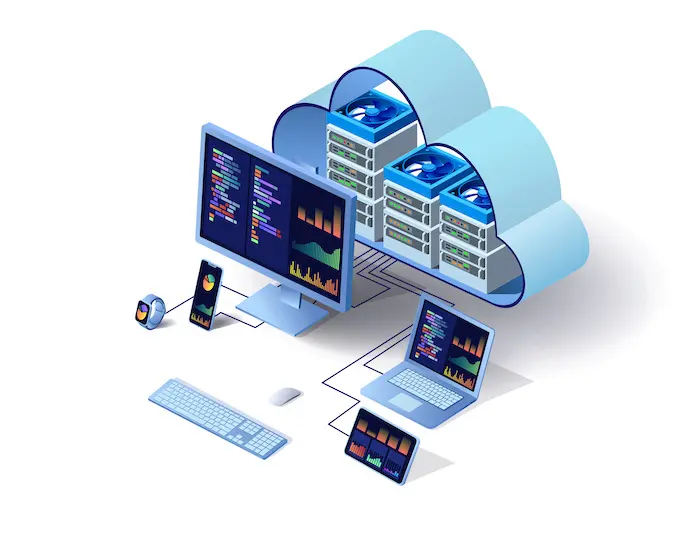What is software as a service?
A cloud provider hosts applications and makes them online accessible to customers as part of the software as a service (SaaS) distribution paradigm. In this paradigm, a third-party cloud provider may be hired by an independent software vendor (ISV) to host the application. SaaS, along with platform as a service and infrastructure as a service (IaaS), is one of the three basic types of cloud computing (PaaS). SaaS apps are used by a variety of IT specialists, business users, and private consumers. SaaS products are commonly promoted to both B2B and B2C users, unlike IaaS and PaaS.
How does software as a service operate?
SaaS utilizes the cloud delivery model to function. An ISV may hire a cloud provider to host the program in the provider’s data center, or a software provider may host the application and accompanying data using its own servers, databases, networking, and computing capabilities. Any device with a network connection will be able to access the program. Web browsers are often used to access SaaS apps. Because of this, businesses who use SaaS apps are not required to set up and maintain the software. Users can access the program by just paying a membership charge, which is an already-made solution.SaaS is closely related to the on-demand computing and application service provider (ASP) software delivery models, where the provider hosts the client’s software and sends it via the internet to authorized end users.In the software-on-demand SaaS model, a single copy of an application that the provider developed especially for SaaS distribution is made available to consumers via a network. All clients share the same source code for the application, and as new features or functionalities are made available, they are distributed to all users. The customer’s data for each model may be kept locally, in the cloud, or both locally and in the cloud depending on the service-level agreement.Using application programming interfaces, businesses can combine SaaS apps with other software (APIs). A company may, for instance, create its own software tools and interface them with the SaaS service using the APIs of the SaaS provider.
The SaaS architecture
A single instance of the SaaS application will be operating on the host servers and will be used to serve each subscribing client or cloud customer. SaaS applications and services often employ a cross strategy. All clients, or tenants, will use the same version and configuration of the application. The data from various clients will still be separated even though they will run on the same cloud instance with a shared platform and architecture. Because SaaS applications typically have a multi-tenant architecture, the cloud service provider can manage maintenance, upgrades, and problem fixes more quickly, easily, and effectively. Engineers can make the necessary adjustments for all clients by maintaining the single, shared instance rather than having to implement changes in many instances. Additionally, multi-tenancy makes a bigger pool of resources accessible to more users while maintaining key cloud features like security, speed, and privacy.
Benefits of SaaS
Organizations no longer need to install and run apps on their own PCs or in their own data centers thanks to SaaS. This removes the cost of purchasing, procuring, and maintaining hardware as well as purchasing, installing, and supporting software.
Adjustable payments:- Customers who use SaaS offerings do not need to buy software to install or additional gear to support it. Many firms can practice more accurate and dependable budgeting when charges are converted to recurrent operating expenses. In order to stop these recurring payments, users can also cancel SaaS solutions at any moment.
Scalable usage:-High vertical scalability is a feature of cloud services like SaaS that offers users the flexibility to acquire more or fewer services or features as needed.
Regular updates:-Customers can rely on a SaaS provider to automatically handle upgrades and patch management rather than buying new software. This lessens the workload for internal IT employees even further.
Availability and persistence:-Users can access SaaS apps from any internet-enabled device and location because SaaS companies deliver their products via the internet.
Customization:-SaaS apps, particularly those from the same software supplier, are frequently customizable and can be connected with other corporate systems.
challenges and risks of SaaS
SaaS also presents certain potential dangers and difficulties because companies must rely on outside providers to deliver the software, maintain it, manage and report proper billing, and offer a safe environment for the company’s data.
Issues beyond customer control:-The ability of clients to use the SaaS offering may be significantly impacted when service interruptions, unwelcome changes to service offerings, or security breaches occur at the providers. Customers should be aware of and ensure compliance with their SaaS providers in order to prevent these problems from occurring.
Customers lose control over versioning:- Whether or not a consumer desires the newer version, if a provider adopts a new version of an application, it will roll out to all of its customers. The company might need to allocate more time and funds for training as a result.
Difficulty switching vendors:- Switching suppliers can be challenging, as it is with using any cloud service provider. Customers must migrate extremely huge volumes of data in order to change vendors. The usage of proprietary technologies and data types by some suppliers can also make it more difficult to transfer consumer data between multiple cloud providers. When a consumer finds it difficult to switch service providers as a result of these circumstances, vendor lock-in occurs.

